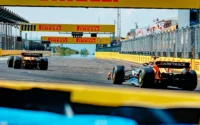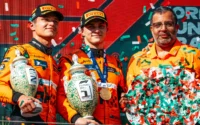The Hungaroring, nestled in Mogyoród, Pest County, Hungary, is a 4.381 km (2.722 mi) racetrack renowned for hosting the Formula One Hungarian Grand Prix. This circuit holds a special place in motorsport history, as it was the venue for the first Formula One Grand Prix to be held behind the Iron Curtain in 1986.
The creation of the Hungaroring was influenced by the geopolitical context of the time. Bernie Ecclestone, a leading figure in Formula One management, initially had aspirations to introduce a race in the USSR. However, it was a recommendation from a Hungarian acquaintance that shifted his focus towards Budapest, Hungary. This decision was pivotal, as it marked a significant expansion of Formula One into the Eastern Bloc during the Cold War era.
Hungaroring Circuit
| First Grand Prix | 1986 Hungarian Grand Prix |
| Number of Laps | 70 |
| Circuit Length | 4.381km |
| Race Distance | 306.63 km |
| Lap Record | 1:16.627 Lewis Hamilton (2020) |
Circuit
When was the Hungaroring built?
The initial proposal was to create a street circuit in Népliget, Budapest’s largest park, envisioning a track akin to the iconic Circuit de Monaco. However, the Hungarian government opted for a different approach, constructing a new circuit just outside the city, near a major highway.
This decision led to the creation of the Hungaroring, a circuit that would become a significant venue in Formula One history. Remarkably, the construction of the Hungaroring began on October 1, 1985, and it was completed in just eight months – a record-breaking timeframe for constructing a Formula One circuit.
The selection of Budapest and the construction of the Hungaroring were not just about expanding the sport’s geographical footprint; they also symbolised the breaking down of political barriers through sports. The Hungarian Grand Prix at the Hungaroring became a landmark event, showcasing the ability of Formula One to bridge divides and bring a high-profile international sporting event to a region that had previously been isolated from such global competitions.
Over the years, the Hungaroring has become a staple on the Formula One calendar, known for its tight and twisty layout that poses a unique challenge to drivers and teams. The circuit’s design, which limits overtaking opportunities, demands technical skill and strategy, making it a favourite among drivers and fans.
The Hungaroring has also been the venue where two celebrated drivers clinched World Championship titles: Nigel Mansell achieved this feat in 1992, and Michael Schumacher followed suit in 2001. The Hungaroring has also seen the Constructors’ Championship title secured by two teams: Williams in 1996 and Scuderia Ferrari in 2001, 2002, and 2004.
When was the first Hungarian Grand Prix?
The first race at the Hungaroring was held on March 24, 1986, and was dedicated to the memory of János Drapál, the first Hungarian to win a motorcycle Grand Prix race.
As well as becoming the first Formula One Grand Prix to take place behind the Iron Curtain it saw, Nelson Piquet snatch victory for Williams with a daring overtake around the outside of Ayrton Senna’s Lotus to take the lead.
Known for its tight and twisty layout, which typically presents limited overtaking opportunities, Piquet’s move has since become a part of F1 folklore, remembered as a moment when skill, courage, and racing strategy converged to produce an unforgettable spectacle in the sport’s history.
The event not only marked the debut of the Hungaroring on the Formula 1 calendar but also helped establish the circuit as a challenging and exciting venue for Grand Prix racing that could produce thrilling and unexpected moments.
The Hungaroring also features turns that have been named in honour of notable incidents involving famous drivers. Turn 4 is known as the Nigel Mansell turn, a homage to the 1987 Hungarian Grand Prix where Mansell lost a wheel at this very spot. Similarly, Turn 11 has been named after Jean Alesi, commemorating the significant crash he suffered during the qualifying round of the 1995 Hungarian Grand Prix at this turn. These named curves add a layer of historical significance to the track, marking memorable moments in Formula 1 history.
Hungaroring lap record
The official lap record for the current F1 Grand Prix circuit layout is 1:16.627, set by Lewis Hamilton during the 2020 Hungarian Grand Prix driving for Mercedes.


